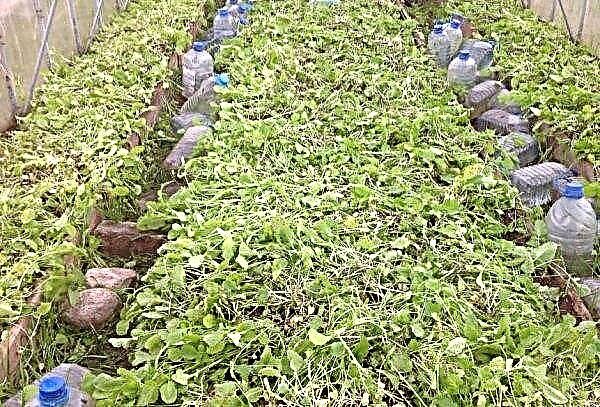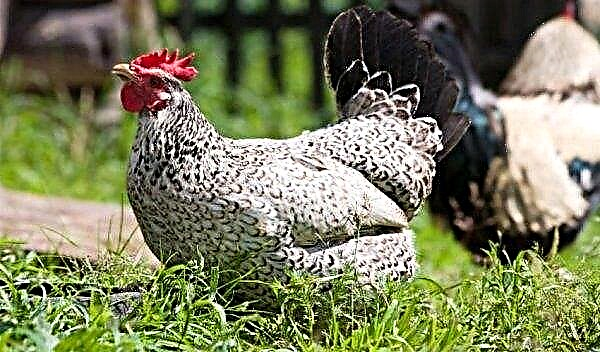Cauliflower is an amazing vegetable crop, because it’s not traditional parts of the plant (fruits, leaves, stems, roots) that are used for food, but inflorescences. To avoid mistakes when growing this useful vegetable, which will not allow the formation of inflorescences, it is worth adhering to the correct agricultural technique.
Basic rules for growing cauliflower
Cauliflower is grown by the seedling method, and seeds are sown approximately 45 days before the alleged cabbage is planted on the land.
The main stages of growing seedlings:
- Seed preparation. Before planting, a disinfection procedure is carried out by placing the seeds in a saturated solution of potassium permanganate for 10 minutes, and then washed with water.
- Preparation of landing tanks and soil. Cauliflower seedlings tolerate picking very poorly, therefore, it is recommended to plant the seeds immediately in individual pots (glasses), which are thoroughly washed and rinsed with boiling water. Soil can be purchased in specialized stores or prepared independently, adhering to the proportions: peat and sand - 1 part, respectively, humus - 10 parts. The acidity of the soil should be neutral, it is desirable to add ash to the prepared soil - it neutralizes the excess acid and enriches the earth with phosphorus, manganese and boron.
- Seedling care. To obtain strong healthy plants, it is necessary to observe the correct temperature regime. Unlike many heat-loving vegetable crops (peppers, eggplant, cucumbers), for cauliflower seedlings after emergence, the optimum temperature for proper development should not be higher than + 22 ° C. Otherwise, the plants become thinner, stretch upward, which is subsequently fraught with the absence of inflorescences. The night temperature in the room with seedlings is about + 10 ° C, during the day - + 18 ° C.
- Top dressing. After the appearance of three leaves on the seedlings, they are fed by spraying with a solution of boric acid (in a proportion of 2 g per 1 liter of water), and in the phase of the appearance of 4 leaves - 0.5% solution of ammonium molybdate (dissolve 5 g in a bucket of water). To increase cold resistance, one week before planting seedlings in open ground, feed it with phosphorus-potassium fertilizers.
Did you know? Cauliflower got its name not at all for its coloring (green, purple, orange varieties). Her head of cabbage is shoots with flowers, tightly adjacent to each other.
Stages of growing cauliflower in open ground:
- Planting seedlings on beds is carried out in organic fertilized soil (humus, mullein), well spilled with water, according to a 50x25 cm pattern. Before each planting, it is advisable to pour a glass of wood ash into each hole. The seedlings are buried so that the first leaf is located immediately on the surface of the earth, watered and covered with non-woven material for several days to avoid the possible appearance of a cruciferous flea.
- Watering in the process of plant growth is carried out about 1 time per week, avoiding excessive waterlogging of the soil. Weeding is best replaced by mulching to avoid injury to the superficial root system. But the drying out of the soil during the formation of the heads cannot be allowed.
- Initially, plants are fertilized 10 days after transplanting seedlings in open ground. Secondarily, fertilizers are applied 2 weeks after the first. The third top dressing - 14 days after the second. To make fertilizer mixtures follows at the rate of 1 liter per plant. Organic top dressing - an aqueous solution of manure (10: 1) or bird droppings (15: 1), to which a complex of trace elements from magnesium, boron, manganese, and molybdenum is added. Inorganic dressing - 20 g of potassium chloride and urea and 50 g of superphosphate are dissolved in 10 l of water.
- In the process of plant growth, earthing should be carried out, evenly sprinkling earth to the stems. This will develop the root system and strengthen the stem.
- After the formation of inflorescences in the head, cabbage should be protected from excessive solar exposure and wind. Shading is carried out as follows: the upper leaves are collected over a head of cabbage, the bundle is fixed with clips.
- As regards pest control, the most common and safe way is dusting the soil and plants with wood ash (1 glass of ash per 1 m²). When pests (cabbage caterpillars or scoops) appear, immediately treat the plants with Dendrobacillin or Enterobacterin.

Why there is no ovary on cauliflower
There are many reasons for the incorrect formation of cauliflower inflorescences. Below we will consider the most common mistakes in growing vegetables that do not allow the plant to form inflorescences.
Did you know? Cauliflower contains sulforaphane, an organic compound with antitumor properties. But for the substance to "work", cabbage must be consumed raw.
Poor seed quality
The choice of seeds should be approached responsibly, since cauliflower is very whimsical in growing, so you need to carefully study the information about a particular variety. In addition to the fact that the seeds of the selected variety or hybrid must be regionalized, one should not forget that varieties suitable for growing in open ground are not suitable for growing in a greenhouse, and vice versa. The information on the packaging with seeds about the ripening dates cannot be ignored, because for each (early, mid-ripening, late) agricultural technology will have significant differences. And, of course, the seeds are worth buying from a reputable, certified producer.
The information on the packaging with seeds about the ripening dates cannot be ignored, because for each (early, mid-ripening, late) agricultural technology will have significant differences. And, of course, the seeds are worth buying from a reputable, certified producer.
Inaccuracies in care
In order for cauliflower to be formed into full heads, you need to pay attention to possible shortcomings in the cultivation of plants.
Violation of the landing time
Having miscalculated a little with the planting date, you can not wait for a full crop. Dates of planting seeds of early ripe varieties of cauliflower for seedlings occur in the first decade of March, while later varieties - on the 20th of March. It is very important to observe the temperature regime after placing the seeds in the ground. Before the appearance of the first shoots, the temperature in the room should not fall below +20 ... + 25 ° C, after which the plants can withstand a week at + 10 ° C.
Important! If, when transplanting seedlings, the air temperature drops below + 15 ° С, then in a month the cabbage will go into arrows with seeds, and the head will not form.
Subsequently, before planting seedlings in open ground, the temperature regime should correspond to + 20 ° C in order to avoid the formation of heads too early. Planting seedlings of early ripe varieties in open ground begins in early May, with an interval of several days, which will subsequently allow you to get a crop that ripens gradually.
Later varieties are planted starting in the last decade of May. Of course, first of all, it is worth being guided by weather conditions. The air temperature should be stable during the day at a mark not lower than + 18 ° C.
Lack of nutrition
Compliance with the norms and terms of fertilizer application is the key to a full crop.
Consider how fertilizers affect the development of cauliflower:
- With an insufficient amount of nitrogenous compounds in the soil, cabbage slows its growth, the color of the leaves becomes faded, and the lower leaves become atypical reddish or blue. Nitrogen starvation is especially negative for young plants of early varieties that cannot fully enter growth. To do this, add nitrogen-containing substances - urea or ammonium nitrate, but strictly observing the dosage, since an excess of nitrogenous substances leads to the formation of huge leaves, and the head of inflorescences may not form at all.
- With a lack of phosphorus, the plant stops growing, the leaves become smaller and change color to purple, there are no ovaries of inflorescences. In soils with high acidity, phosphorus is not fully absorbed, therefore, in order to eliminate this disadvantage, liming of the soil should be made.
- Potassium deficiency leads to yellowing of plants, looks like a burn. Plants weaken, becoming an easy target for pests. It is necessary to immediately feed the plants with potash fertilizers.
- With a lack of magnesium, the plant acquires a light marble shade, starting from the top. With a very large drawback - the leaves die off completely, the plant dies. Magnesium preparations, such as Kalimag, Kalimagnesia, or magnesium sulfate are introduced very carefully, strictly following the instructions, because an excess of this element is as harmful to cabbage as its lack.
Important! To avoid disease, do not plant 2 years in a row cabbage in the same place. Its best predecessors are cucumbers, potatoes, beans.
Wrong watering
As mentioned above, cauliflower is recommended to be watered once a week. More frequent watering can lead to excessive growth of the root system, and inflorescences will not be formed. Excess moisture can lead to the spread of rot and mold on plants. However, a lack of moisture can lead to a complete loss of crop.
Diseases and pests
The most famous and harmful diseases for cabbage plants are as follows:
- Mucosal bacteriosis - occurs due to improper watering (the water balance of the plant is disturbed). It is indicated by the appearance of putrefactive spots on the head of cabbage, which spread rapidly. With a small lesion, the rot is removed with a sharp knife, capturing the unaffected inflorescences. If the process has spread to most of the vegetable, it should be torn off the bed and burned.

- Blackleg - affects plants in the seedling phase. The base of the stem becomes dark in color, softens, the plant dies. If signs of the disease are found in several plants, they should be destroyed immediately to prevent the disease from spreading to healthy seedlings. As a prophylaxis, it is recommended to treat the plants with Previkur 607 SL.

- Alternariosis - characterized by a sharp darkening of the leaves with the subsequent appearance of concentric circles. Prevention consists in treating seeds before planting on seedlings with Planriz and Tiram preparations. During the growing season, it is necessary to treat the plants with copper preparations, for example, Bordeaux liquid, copper sulfate.

- Kila - It is considered the most harmful disease, affecting the root system of cauliflower with a fungal infection. It is manifested by growths of large sizes on the roots, after which the process of decay occurs. The plant dries and soon dies. For prevention, it is advised to enrich the soil with ash. At the end of the season, it is necessary to sprinkle the soil with dolomite flour (25 g / 1 l).

- Downy mildew (peronosporosis) - affects leaves, which subsequently die off. It is characterized by a white coating. Excessive cabbage planting contributes to this disease. To prevent the spread of the disease, the beds are sprayed with Bordeaux liquid (1%) or Polycarbacin (0.4%).

In addition to diseases, irreparable damage to vegetable crops is caused by pests.
The most common types and methods of dealing with them are presented below:
- Cabbage fly - This pest can be recognized by the larvae and eggs that the fly lays near the stems. They should be cleaned immediately, grabbing part of the soil, after which they spud cabbage, adding fresh soil. Since the cabbage fly lays eggs several times during the season, the procedure will have to be repeated. In addition, a good result is given by sprinkling the earth around the plant with a mixture of wood ash and tobacco dust in a ratio of 1: 1. It has been observed that nearby growing celery adversely affects the pest and can significantly reduce the negative effect of this insect.

- Cruciform flea - harms all parts of plants. Weeds contribute to the active reproduction and spread of the harmful insect, therefore, the constant removal of weed vegetation from the beds and soil cultivation under plants with lime or ash are the main methods of controlling the flea. Planted next to garlic and tomatoes protect cauliflower from this pest.

- Cabbage whitewash (scoop) - lays eggs on the leaves. You need to carefully inspect the plants, if necessary, collect eggs manually. Scoops at all stages of development are destroyed with the help of the drugs "Bitoxibacillin", "Lepidocide", which are used according to the instructions for them.

What to do and how to solve the problem
The main points that must be taken into account in the agricultural technology of cauliflower for the formation of full-fledged inflorescences are as follows:
- In order for the cabbage to be with large heads and dense inflorescences, it is necessary to choose the right seeds (zoned).
- The soil for planting should be prepared in advance, in the fall, carefully removing weeds and making compost and humus.
- Carefully monitor the timely introduction of fertilizers and minerals into the soil at all stages of plant development. The main task is to ensure conditions under which all cabbage inflorescences form at the same time, forming a tight head. To do this, it is necessary to add boron, potassium and phosphorus, and reduce the nitrogen content - flowering will accelerate, leaf growth will decrease.
Preventive measures
Cauliflower is a capricious vegetable crop, so to get a good harvest, emphasis should be placed on preventive measures. Timely cultivation of soil and seedlings with antifungal and antiviral agents, rational watering, observing light and temperature conditions, regular watering and top dressing are the key to the timely appearance of ovaries and the correct formation of inflorescences.
Cauliflower is rightfully considered the “queen” among numerous varieties of cabbage and is highly regarded for its delicate taste and the benefits it brings to the human body. With some effort, you can grow this plant in your garden and enrich your diet with a healthy food.




















